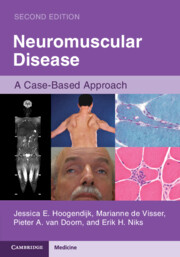Book contents
- Neuromuscular Disease: A Case-Based Approach
- Neuromuscular Disease
- Copyright page
- Contents
- Contributors
- Foreword
- Preface to 2nd Edition
- Part I Evaluation and Treatment of Patients with a Neuromuscular Disorder
- Part II Neuromuscular Cases
- Disorders of the Anterior Horn Cell
- Peripheral Neuropathies
- Disorders of the Neuromuscular Junction
- Myopathies
- Case 36 Duchenne Muscular Dystrophy (DMD)
- Case 37 Becker Muscular Dystrophy (BMD)
- Case 38 Facioscapulohumeral Muscular Dystrophy (FSHD)
- Case 39 Myotonic Dystrophy Type 1 (DM1)
- Case 40 Myotonic Dystrophy Type 2 (DM2)
- Case 41 Limb Girdle Muscular Dystrophy (LGMD) R1, Calpain-Related
- Case 42 Limb Girdle Muscular Dystrophy (LGMD) R9, FKRP-Related
- Case 43 Bethlem Myopathy, a Collagen VI-Related Myopathy (LGMDD5); Ullrich Congenital Muscular Dystrophy
- Case 44 Oculopharyngeal Muscular Dystrophy (OPMD)
- Case 45 Emery–Dreifuss Muscular Dystrophy (EDMD)
- Case 46 Caveolinopathy, Rippling Muscle Disease
- Case 47 Distal Myopathies: Miyoshi Myopathy, Dysferlinopathy; Anoctaminopathy
- Case 48 Distal Myopathies: GNE Myopathy
- Case 49 Myofibrillar Myopathies: Desminopathy
- Case 50 Skeletal Muscle Channelopathies: Non-Dystrophic Myotonia; Myotonia Congenita (Becker)
- Case 51 Skeletal Muscle Channelopathies: Hypokalaemic Periodic Paralysis
- Case 52 Pompe Disease (Glycogen Storage Disease (GSD) Type II; α-Glucosidase Deficiency)
- Case 53 McArdle Disease (Glycogen Storage Disease (GSD) Type V); Myophosphorylase Deficiency, Rhabdomyolysis
- Case 54 Carnitine Palmitoyltransferase-II (CPT2) Deficiency
- Case 55 Mitochondrial Myopathies: Chronic Progressive External Ophthalmoplegia (CPEO)
- Case 56 Ryanodine Receptor 1 (RYR1)-Related Disorders
- Case 57 Congenital Myopathies: X-Linked Myotubular Myopathy
- Case 58 Congenital Myopathies: Nemaline Myopathy
- Case 59 Juvenile Dermatomyositis (JDM)
- Case 60 Dermatomyositis (DM)
- Case 61 Immune-Mediated Necrotizing Myopathy (IMNM)
- Case 62 Inclusion Body Myositis (IBM)
- Case 63 Endocrine Myopathy: Hypothyroid Myopathy; Hyperthyroid Myopathy
- Case 64 Drug-Induced Myopathies: Hydroxychloroquine Myopathy
- Case 65 A- or Paucisymptomatic HyperCKaemia
- Cases 66 Exertional Rhabdomyolysis
- Video legends
- Index
- References
Case 46 - Caveolinopathy, Rippling Muscle Disease
from Myopathies
Published online by Cambridge University Press: 29 November 2024
- Neuromuscular Disease: A Case-Based Approach
- Neuromuscular Disease
- Copyright page
- Contents
- Contributors
- Foreword
- Preface to 2nd Edition
- Part I Evaluation and Treatment of Patients with a Neuromuscular Disorder
- Part II Neuromuscular Cases
- Disorders of the Anterior Horn Cell
- Peripheral Neuropathies
- Disorders of the Neuromuscular Junction
- Myopathies
- Case 36 Duchenne Muscular Dystrophy (DMD)
- Case 37 Becker Muscular Dystrophy (BMD)
- Case 38 Facioscapulohumeral Muscular Dystrophy (FSHD)
- Case 39 Myotonic Dystrophy Type 1 (DM1)
- Case 40 Myotonic Dystrophy Type 2 (DM2)
- Case 41 Limb Girdle Muscular Dystrophy (LGMD) R1, Calpain-Related
- Case 42 Limb Girdle Muscular Dystrophy (LGMD) R9, FKRP-Related
- Case 43 Bethlem Myopathy, a Collagen VI-Related Myopathy (LGMDD5); Ullrich Congenital Muscular Dystrophy
- Case 44 Oculopharyngeal Muscular Dystrophy (OPMD)
- Case 45 Emery–Dreifuss Muscular Dystrophy (EDMD)
- Case 46 Caveolinopathy, Rippling Muscle Disease
- Case 47 Distal Myopathies: Miyoshi Myopathy, Dysferlinopathy; Anoctaminopathy
- Case 48 Distal Myopathies: GNE Myopathy
- Case 49 Myofibrillar Myopathies: Desminopathy
- Case 50 Skeletal Muscle Channelopathies: Non-Dystrophic Myotonia; Myotonia Congenita (Becker)
- Case 51 Skeletal Muscle Channelopathies: Hypokalaemic Periodic Paralysis
- Case 52 Pompe Disease (Glycogen Storage Disease (GSD) Type II; α-Glucosidase Deficiency)
- Case 53 McArdle Disease (Glycogen Storage Disease (GSD) Type V); Myophosphorylase Deficiency, Rhabdomyolysis
- Case 54 Carnitine Palmitoyltransferase-II (CPT2) Deficiency
- Case 55 Mitochondrial Myopathies: Chronic Progressive External Ophthalmoplegia (CPEO)
- Case 56 Ryanodine Receptor 1 (RYR1)-Related Disorders
- Case 57 Congenital Myopathies: X-Linked Myotubular Myopathy
- Case 58 Congenital Myopathies: Nemaline Myopathy
- Case 59 Juvenile Dermatomyositis (JDM)
- Case 60 Dermatomyositis (DM)
- Case 61 Immune-Mediated Necrotizing Myopathy (IMNM)
- Case 62 Inclusion Body Myositis (IBM)
- Case 63 Endocrine Myopathy: Hypothyroid Myopathy; Hyperthyroid Myopathy
- Case 64 Drug-Induced Myopathies: Hydroxychloroquine Myopathy
- Case 65 A- or Paucisymptomatic HyperCKaemia
- Cases 66 Exertional Rhabdomyolysis
- Video legends
- Index
- References
Summary
Since early childhood, a 22-year-old-man had difficulty keeping up with his peers at gym class activities. He noticed increasing weakness in his leg muscles when getting up the stairs, and gradually his arm muscles were also involved. He had noticed rolling movements of his thigh muscles triggered by exercise and squeezing the muscles.
Family history was positive: his brother, mother, maternal grandfather, maternal aunt, and nephew had similar complaints.
Keywords
- Type
- Chapter
- Information
- Neuromuscular DiseaseA Case-Based Approach, pp. 200 - 201Publisher: Cambridge University PressPrint publication year: 2024

